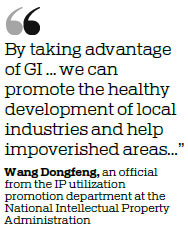
Geographical indication, an important element of some intellectual properties, is closely bound with issues relating to agriculture, rural areas and rural people, and is playing an increasingly important role in targeted poverty alleviation.
GI identifies a product's origin, quality and reputation. It is determined by the natural and human factors of the place of production, with the product's quality having a close connection with the geographical environment such as water, soil and climate.
In terms of promoting the image of local specialties and increasing the added value of agricultural products, GI plays an irreplaceable role, which has been proven in Guizhou province in Southwest China.
Guizhou has had an array of successful examples of using GI to develop its agricultural economy.
Weining county of Bijie city in the province has been able to industrialize its potato plantations since it received approval for the registration of the GI trademark of "Weining potato" in 2009.

Scaled-up plantations, standardized production, refined processing and branded marketing have helped to develop the county into one of the main potato producing areas in southern China.
Weining has more than 1.27 billion square meters of potato plantations. The per capita net income of local farmers from the potato industry exceeds 1,600 yuan ($230), accounting for more than 22 percent of the per capita net income of all the farmers in the county.
Meitan county in Zunyi, Guizhou province has tea plantations covering 400 million square meters.
The county has received two GI trademarks for its tea brands - "Meitan Cuiya" and "Zunyi Hong"-in the past 10 years.
After years of protection and publicity of the two GIs, the county has been able to grow its tea industry, and has helped lift local tea farmers out of poverty.
Meitan is a key county for poverty alleviation, with 43,689 people in 12,961 households living below the poverty line.
However, as of September 2018,Meitan has been removed from the list of poverty-stricken counties, with 35,777 people in 9,913 households shrugging off poverty.
A similar story happened in Guizhou's Xiuwen county, where farmers have been planting kiwi fruit for more than 30 years. But due to the lack of brands and quality control, the county's kiwis were priced low.
The county successfully registered a GI trademark for its kiwi fruit in 2009. To date, 64 farmers, companies and cooperatives have been approved to use the GI trademark.
"We had to walk 1 kilometer, carrying the kiwi, and then take a bus to the county to sell before. The price was just 1 to 2 yuan per 500 grams. But now, the price has increased to more than 6 yuan per 500 grams," local villager Li Xuemei said.
As of the end of 2018, there were 111.33 million sq m of kiwi fruit orchards in Xiuwen county, which had created 52,000 jobs for local people and increased per capita annual income by more than 8,000 yuan.
Through scientific management, ecological cultivation and order-based sales, the county's kiwis are in line with the export standards of the European Union, and have been exported to Russia, Japan and Southeast Asia, local officials said.
"By taking advantage of GI and telling the stories of Guizhou, we can promote the healthy development of local industries and help impoverished areas in the province get rid of poverty as soon as possible," said Wang Dongfeng, an official from the IP utilization promotion department at the National Intellectual Property Administration.
zhangdandan@chinadaily.com.cn
|
A farmer picks tea leaves in a field in Meitan, Guizhou province. Liu Xu / Xinhua |
(China Daily 09/19/2019 page17)